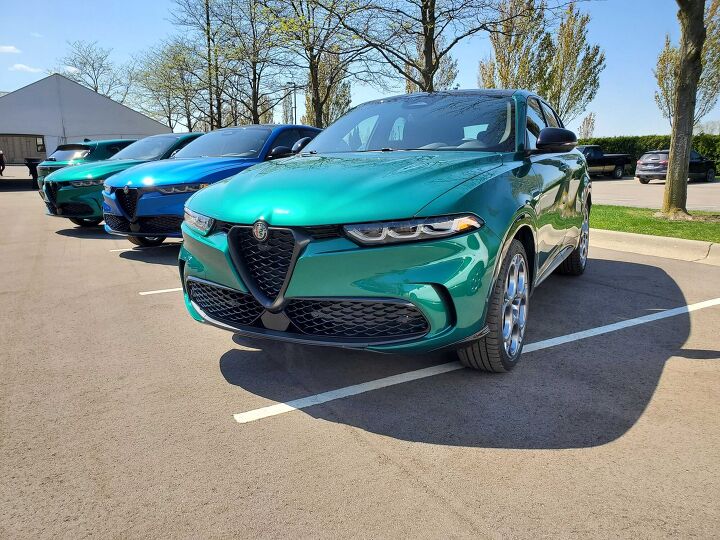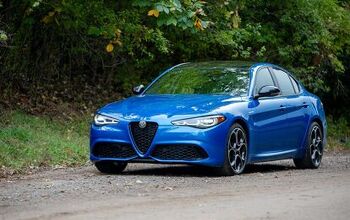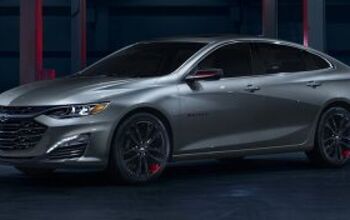2024 Alfa Romeo Tonale Review — Bada Bing

The Alfa Romeo Tonale is one of those vehicles that I expected to dislike and was quickly won over by. Despite being a rolling conflict of powertrains, purpose, and badge engineering, it’s about as enjoyable as a small crossover gets.
While I try to remain objective, the car had run afoul of my automotive prejudices before it had even been shipped stateside. Sporting crossovers never made a lot of sense to me and the Tonale’s 1.3-liter turbocharged four-cylinder paired with an electric motor on the rear axle stinks of European emissions compliance. Alfa Romeo has likewise been talking a big game about going all-electric, making me wonder how their holdover combustion vehicles are going to fare when nobody running the business wants you to buy them.
An ungodly amount of traffic and roadworks further lowered my spirits en route to the driving event. But this turned out to be a blessing in disguise for the Tonale, as I learned that it remains amenable in most environments and eager to please even when there’s not a lot of open road to work with.
(Full disclosure: Alfa Romeo invited me to a drive event in Lake Orion, Michigan, where I was offered a delicious-looking Italian lunch that I declined. While I provided my own transportation and lodging, I did grab a soda from one of their coolers. I am only human.)
Let’s start with the powertrain. Unlike its domestic sibling, the Dodge Hornet, Alfa’s Tonale only comes as a plug-in hybrid (PHEV) and it will try to lean on the electric motor whenever possible if left to its own devices. Even the most hardcore driving mode still tries to prioritize electric propulsion at low speeds while the adaptive exhaust system is burbling at idle — the engine itself doing nothing. But you can override this by swapping the vehicle into manual mode and running the six-speed transmission however you want. You can likewise opt to use the gear selector to shift up and down or grab onto the absolutely massive paddle shifters.
Frankly, the amount of on-the-fly driving customization was the most impressive thing about the vehicle. While there are certainly features buried within the 10.3-inch touchscreen menus, Uconnect 5 is a pretty innate operating system and Alfa put all the important stuff on buttons and knobs. If you want to make the car go from placid to vicious, all you have to do is turn the applicable dial and the vehicle complies immediately. Otherwise, it’ll jump between (electric) rear-wheel drive and all-wheel drive with the gasoline engine handling the vehicle’s front wheels.
Selective drive modes include Dynamic (Sport Mode), Natural (Normal Mode), Advanced Efficiency (Nerd Mode), and ESC Off (Extra Fun Mode). Assuming you optioned it on the Tonale (the Veloce trim has it), you can also adjust the suspension dampening with a singular button push. The whole thing is highly intuitive, came in handy whenever I came across construction zones, and was a lot of fun to play with.
Considering how bad the roads seem to be these days, I would likely keep the crossover in Dynamic with the softer suspension (MacPherson struts all around) setting and do all of the gear selecting myself at the expense of a higher gas bill. But most drivers will probably just leave it in Normal (the regenerative braking is wild on Dynamic) and have the car decide what characteristic to assume based on how heavy their foot happens to be at any given moment.
Still, if you want to try and be frugal, the 14.8-kWh battery will do 30 miles all by itself if you’ve plugged it in and given it a full charge. Meanwhile, the total driving range should be somewhere around 320 miles. Fuel economy is said to be 29 mpg on the highway and 23 around town.
With help from the 90-kW electric motor, the 1.3-liter turbo produces 285 horsepower and a very healthy 347 pound-feet of torque. This makes for a sprightly 0-60 mph launch, which Alfa Romeo claimed would be finished in about 5.6 seconds.
It’s slightly less punchy than its large torque numbers would suggest due to the 4,133-pound curb weight. Though the electric motor makes the Tonale feel as if it’s always right in the middle of the torque curve and whooshes you up to speed in a manner that’s akin to what you’d find on a playful all-electric vehicle. It’s very satisfying and makes the car enjoyable to drive at just about any speed.
My expressway time was limited. But the Alfa continued to offer lively acceleration beyond speeds that would be deemed legally acceptable. Provided you don’t want to drive above its pre-programmed limitation of 125 mph, you should be pleased on any exuberant road trips. You’ll also be happy to see that the manufacturer issued the car with road-sign recognition that displays the intended speeds issued by the local government and turns red whenever you’ve exceeded said limits.
The handling was shockingly flat for a crossover and helped it through turns without any unpleasant surprises. But I was unable to test the outer extent of the Tonale’s cornering capability due to there being too much traffic and an obscene amount of construction. If I had to complain about anything here, it’s that the electronic steering feels — well — electronic. It does clash a little with the firmer-than-average suspension. But this also means it can be tightened up in the more aggressive driving modes and at higher speeds while remaining easygoing during parking maneuvers.
Speaking of parking, I had a few concerns about backing the Tonale up. Rearward visibility is lacking due to thick roof pillars and protruding rear headrests. But the electronic helpers are excellent and the side mirrors are actually big enough to be quite useful. Unless you’re someone who has never driven a vehicle with blind spots, it’s wholly manageable.
Otherwise, there is not much to dislike about being inside the vehicle. On the Veloce, you get leather seats and more premium buttons to fondle. It’s an exceptionally nice space to occupy, with a premium-sporting bend that’s extremely rare within the small crossover segment. Frontal space is particularly impressive. While I had heard some negative rumblings about rear-occupant comfort in the Dodge Hornet, I failed to notice this on the Alfa Romeo Tonale. However, I am admittedly thin compared to most Americans and just under six feet tall.
Wireless Apple CarPlay, wireless Android Auto and wireless charging are all standard. Though there are still a good number of outlets for devices requiring them.
Alexa home-to-car and car-to-home functionality is also here. But I’m not a big enough geek to appreciate it, nor am I someone who would utilize Alfa Connect to get into additional features (remote monitoring, remote start, etc.) over my phone. But many will, so Stellantis has tossed it into the mix.
Standard safety features include the aforementioned Traffic Sign Recognition; Adaptive cruise control; Intelligent Speed Assist; Blind Spot Detection and Rear Cross Path detection; Forward Collision Warning and Automatic Emergency Braking with pedestrian detection; Driver Attention Assist and rear seat reminder; and Lane Departure with Lane Keep Assist. However, with the exception of Blind Spot Detection and Traffic Sign Recognition, I never bothered to adequately test any of the above — nor had sufficient time in which to do so.
Unfortunately, one of the Tonale Ti models I was going to test after the Veloce had its infotainment system malfunction. My assumption was that it overheated after being left in the hot sun. But the physical portions of the vehicle seemed better put together than some of the interiors I’ve seen from most American manufacturers of late. Here’s hoping it was a fluke, as the Veloce I spent the majority of my day in was trouble-free.
While I am not ready to call the Tonale an outright sports car, it offers so much more personality than just about everything else in the segment that it’s pretty hard to dislike. It also manages to straddle the line between fun and practicality. The burbling exhaust note begins to dissipate once you’re moving along and the extra weight of the battery prohibits it from being a hardcore driver’s car. But Alfa Romeo did a lot with the package it was given and that’s the real takeaway here. If you want something higher riding with a unique persona, the Tonale is certainly worthy of consideration.
But you have to be ready to pay for it. Prices range from $44,590 for the base Sprint to $49,090 for the Veloce and you’ll want the expensive one. Despite carrying a premium Italian badge, this was a vehicle developed on a budget (to be shared across brands) and that becomes apparent once you’ve dropped down to the mid-level Ti trim. Interior equipment feels less premium and you start losing some of the things that make the Tonale feel extra special.
My guess is that it’ll be popular with urban dwellers who want something relatively practical with sporting aspirations and oodles of charm. It probably doesn’t make the best financial sense when Dodge has the Hornet on offer for thousands less. But, anybody eyeballing the Mercedes-Benz GLA, Audi Q3, or BMW X1, would be an idiot to not at least take the Alfa Romeo Tonale for a test drive.
[Images © 2023 Matt Posky/TTAC]
Become a TTAC insider. Get the latest news, features, TTAC takes, and everything else that gets to the truth about cars first by subscribing to our newsletter.

A staunch consumer advocate tracking industry trends and regulation. Before joining TTAC, Matt spent a decade working for marketing and research firms based in NYC. Clients included several of the world’s largest automakers, global tire brands, and aftermarket part suppliers. Dissatisfied with the corporate world and resentful of having to wear suits everyday, he pivoted to writing about cars. Since then, that man has become an ardent supporter of the right-to-repair movement, been interviewed on the auto industry by national radio broadcasts, driven more rental cars than anyone ever should, participated in amateur rallying events, and received the requisite minimum training as sanctioned by the SCCA. Handy with a wrench, Matt grew up surrounded by Detroit auto workers and managed to get a pizza delivery job before he was legally eligible. He later found himself driving box trucks through Manhattan, guaranteeing future sympathy for actual truckers. He continues to conduct research pertaining to the automotive sector as an independent contractor and has since moved back to his native Michigan, closer to where the cars are born. A contrarian, Matt claims to prefer understeer — stating that front and all-wheel drive vehicles cater best to his driving style.
More by Matt Posky
Latest Car Reviews
Read moreLatest Product Reviews
Read moreRecent Comments
- Fred No idea why someone would interested in buying this at the price point. I'm pro-ev but a quick search can pull-up a lot more value at lower costs. I like the Fiat design but I couldn't stomach paying $37k for limited range and a super tight back seat.
- 28-Cars-Later For the you-gotta-be-rich-to-afford-a-cheap-car crowd, Versa is the winner here IMO. Buy it new and pay the $300ish (?) note, but enjoy at least five years with relative reliability assuming historical average miles. Based on MY19, Manheim expects the "S" to be worth $5,975 in roughly five years with "retail" value being $12,650. Nissan and other second or third tier marques will give more on a new trade so assuming 20 OTD with incentives its a 12K/$2,400 depreciation over 5 years excluding interest and it probably could be kept another year or two before the Nissan in it starts to show. Mirage in this comparison is the new buy used on the cheap and run it till the wheels fall off. I'm loathe to compare it to either the Panther or 240 (since I don't believe it could physically last as long as either) but something in the vein of car you could repair yourself on the cheap which was originally intended for Third World conditions. Based on MY19, the ES hatch is worth $4K even with avg miles of 72,740 and "retail" value at $9,650. I personally see it as lot poison and could see savvy buyers making off with one of these near or below wholesale while Nissan is a staple of the subprime crowd and is much easier to finance. MC beings up an interesting contender in the used Chevy Bolt, whose wholesale is $12,050 for MY19 in LT trim with avg lower miles of 33,017. While this is very intriguing, financing is going to be the story here since Nissan or I imagine Mitsubishi could put buyers into half decent rates despite poor credit where a Bolt is "going to the street" and getting whatever high rate is being offered now. Assuming one can handle their own charging, Bolt does offer a lower maintenance cost and used I believe buyers have a higher chance of a white collar professional's commuter condition than what they will find in a used Nissan or Mitsu runabout. The risk to our theoretical buyer IMO is that the Bolt will straight up fail at some point in the future, either not take a charge or even turn on and for the higher wholesale entry point I say the Mitsu is a better choice since it likely won't completely fail and can very cheaply be replaced. Additional: For your kid/nephew/niece/any "middle class" child, I think Bolt is probably the better proposition here but I'd be out of the trade in 36 mos personally. For those truly on their own with no emergency support system, I'd shy away.
- Jbltg It's interesting to note that in the Japan domestic market, where cars are built to order and dealers maintain barely any stock, that there are many, many color options. Really good ones, but no one seems to bite. Most of the cars on the road there are the same boring colors that we have. Go figure.My pet peeve is black interiors. Too depressing, and shows every speck of dust and dirt.
- IBx1 Dealerships flood the market with grayscale cars to commodify them and drive down resale value. Green and yellow cars hold their value best because they cannot easily be replaced, but you can throw a rock and hit fifty shades of gray.
- SCE to AUX Appliances (household and vehicular) have limited color choices, that's why.But today, if you want a crazy color, just buy a plain one and get it wrapped.










































Comments
Join the conversation
This car has brake-by-wire brakes like the Stelvio, which is a deal breaker for me. On a test drive, I found the Stelvio's brakes to be unpredictable and vague, and therefore unsafe. At one point I rolled right through a stop sign after applying similar pressure in a previous stop.
What's wrong with standard hydraulic brakes? Nothing is gained by changing to brake-by-wire.
Sure, an Alfa equipped with the most complex type of hybrid system available. That wounds like a winning combination. /s
I guess a safe candidate to lease, but even then - hope you find a servicing dealer with a good loaner program!